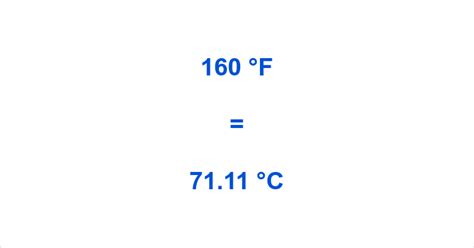What Is 160 Degrees Fahrenheit In Celsius
Kalali
Mar 31, 2025 · 4 min read

Table of Contents
What is 160 Degrees Fahrenheit in Celsius? A Comprehensive Guide
Converting between Fahrenheit and Celsius is a common task, particularly for those working in fields requiring precise temperature measurements or those navigating international recipes and weather reports. This comprehensive guide dives deep into the conversion process of 160°F to Celsius, exploring the underlying formulas, practical applications, and related temperature concepts. We'll also touch upon the history of these temperature scales and offer tips for accurate conversions.
Understanding Fahrenheit and Celsius Scales
Before diving into the conversion, let's briefly understand the two scales:
Fahrenheit (°F): Developed by Daniel Gabriel Fahrenheit in the early 18th century, this scale defines the freezing point of water as 32°F and the boiling point as 212°F, both at standard atmospheric pressure. Its range is broader, often used in the United States, some Caribbean nations, and a few other countries.
Celsius (°C): Also known as the centigrade scale, Celsius was created by Anders Celsius. It sets the freezing point of water at 0°C and the boiling point at 100°C, again at standard atmospheric pressure. It's the most widely used temperature scale globally, adopted by the International System of Units (SI).
Calculating 160°F in Celsius
The conversion between Fahrenheit and Celsius follows a straightforward formula:
°C = (°F - 32) × 5/9
Let's plug in 160°F:
°C = (160 - 32) × 5/9 = 128 × 5/9 = 71.11°C (approximately)
Therefore, 160 degrees Fahrenheit is approximately 71.11 degrees Celsius.
Practical Applications of 160°F (71.11°C)
Understanding the Celsius equivalent of 160°F is crucial in various situations:
Cooking and Baking:
Many recipes, especially those of international origin, utilize Celsius. Knowing that 160°F is roughly 71°C helps in accurate baking and cooking. This temperature range is suitable for tasks like:
- Slow cooking: Maintaining a gentle heat for extended periods to tenderize meats.
- Baking delicate items: Ensuring even cooking for cakes, pastries, and other items sensitive to high heat.
- Candy making: Achieving specific consistencies in various types of candies.
Industrial Processes:
Numerous industrial processes rely on precise temperature control. Accurate conversions are essential to ensure product quality and safety in:
- Food processing: Pasteurization and sterilization of food products.
- Pharmaceutical manufacturing: Maintaining optimal temperatures during drug production.
- Material science: Controlling reaction temperatures in material synthesis and processing.
Weather and Climate:
While Fahrenheit might be used in some weather reports, understanding Celsius equivalents is vital for international comparisons and data analysis:
- Understanding global climate data: Analyzing temperature trends and patterns across different regions.
- Interpreting international weather forecasts: Accessing accurate weather information regardless of reporting format.
Healthcare:
Temperature is critical in healthcare. Accurate conversions are necessary for:
- Interpreting medical data: Understanding patient temperatures from different sources.
- Calibration of medical equipment: Ensuring accurate readings from thermometers and other devices.
Beyond the Conversion: Understanding Temperature Concepts
Beyond the simple conversion, understanding underlying temperature concepts improves comprehension and precision:
Absolute Zero: The lowest possible temperature, where all molecular motion ceases. It is -273.15°C or -459.67°F.
Thermal Equilibrium: The state where two objects in contact have the same temperature, resulting in no net heat transfer.
Heat Transfer: The movement of thermal energy from a hotter object to a cooler object. This process occurs through conduction, convection, and radiation.
Specific Heat Capacity: The amount of heat required to raise the temperature of one unit mass of a substance by one degree. Different substances have different specific heat capacities.
Tips for Accurate Temperature Conversions
To avoid errors, remember these tips:
- Use a reliable calculator: Many online calculators and apps offer accurate conversions.
- Double-check your work: Always verify your calculations to ensure accuracy.
- Understand significant figures: Use an appropriate number of significant figures based on the precision of the initial measurement.
- Consider rounding: Rounding the final answer to an appropriate number of decimal places based on the context.
The History of Fahrenheit and Celsius
Understanding the history of these scales provides context for their use:
Fahrenheit: Developed by Daniel Gabriel Fahrenheit, it originally used a zero point based on a brine solution's freezing point. Later, it was calibrated using the freezing and boiling points of water.
Celsius: Originally known as the centigrade scale, Anders Celsius devised this scale with 0°C representing the boiling point and 100°C representing the freezing point of water. Later, this was reversed to its current standard.
The adoption of Celsius as the global standard highlights the importance of standardization in scientific and everyday applications.
Conclusion: Mastering Temperature Conversions
Mastering the conversion between Fahrenheit and Celsius is a valuable skill with broad applications. Knowing that 160°F is approximately 71.11°C opens doors to more accurate cooking, industrial processes, international communication, and data analysis across various disciplines. Understanding the underlying principles, history, and practical applications enhances your overall understanding of temperature and its role in our daily lives. Remember to utilize accurate conversion methods and double-check your work for precise results. By grasping these concepts, you'll build a stronger foundation for scientific comprehension and practical problem-solving.
Latest Posts
Latest Posts
-
What Is The Percent Of 20 Out Of 25
Apr 02, 2025
-
Where Is The North Magnetic Pole Of This Current Loop
Apr 02, 2025
-
Magnesium Metal Or Nonmetal Or Metalloid
Apr 02, 2025
-
How Many Ounces Are In 125 Ml
Apr 02, 2025
-
What Is 10 Out Of 15
Apr 02, 2025
Related Post
Thank you for visiting our website which covers about What Is 160 Degrees Fahrenheit In Celsius . We hope the information provided has been useful to you. Feel free to contact us if you have any questions or need further assistance. See you next time and don't miss to bookmark.
